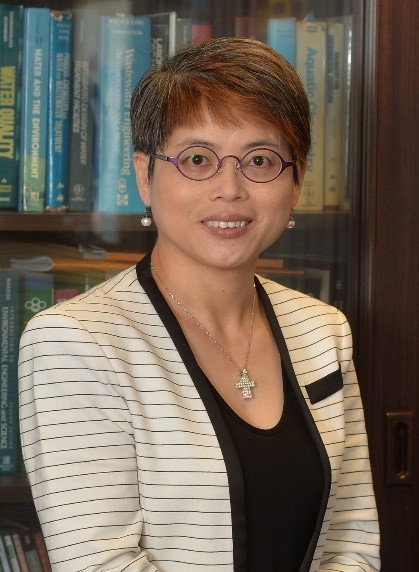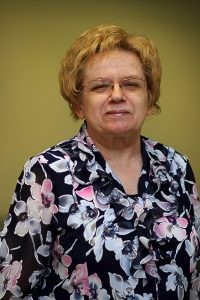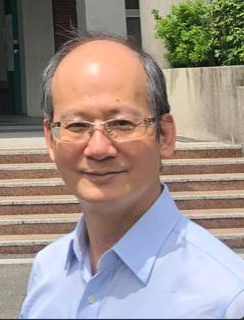Keynote Speakers
Ir Prof Irene M. C. LO
Academician, M.EASA, FASCE, FHKIE, CAP, JPSpeech Title: In situ photoelectrochemical activation of chloride in sewage by an optimized MoS2@BiVO4 photoanode for the simultaneous PPCPs degradation, H2 evolution and E. coli disinfection
Abstract: Pharmaceuticals and personal care products (PPCPs) are ubiquitous pollutants in sewage posing adverse effects on ecosystems and humans, and escherichia coli (E. coli) exists with high density in sewage which may cause several diseases to humans. Driven by solar-light, photocatalysis has been developed for both PPCPs degradation and E. coli disinfection. However, the disadvantages of severe secondary pollution caused by the suspension-type photocatalysts, low efficiency because of high charge recombination, and cannot produce high-value products to offset the treatment cost still hold back its practicability. Herein, we have developed a multifunctional photoelectrochemical (PEC) system for simultaneous PPCPs degradation, E. coli disinfection, and H2 evolution via in situ activation of chloride ions in sewage. To this end, we have synthesized MoS2@BL-BiVO4 photoanode (the photocatalyst was adhered on the conductive glass substrate) with high PEC performance via strategies of reducing bulk and surface recombination. 2 ppm benzophenone-3 and the E. coli in sewage can be completely removed by the PEC system using this photoanode in 30 minutes at 1.0 V vs. Ag/AgCl applied voltage under visible light illumination, simultaneously, 89.32 μmol H2 was produced as the byproduct. Moreover, the PEC system also showed high efficiency for the degradation of ibuprofen and carbamazepine. As a comparison, both electrocatalysis and photocatalysis showed low efficiency toward PPCPs degradation and E. coli disinfection, and cannot yield any H2. The mechanism study revealed that chloride ions in sewage were activated to be chloride-based radicals (•Cl, •ClO) for sewage treatment and reacted with holes to separate more electrons for H2 evolution. Suspension solids and natural organic matters are the main sewage components that impeded the PEC reactions since they can compete for active species with PPCPs and E. coli, and react with electrons. The cycling test revealed that the PEC system has excellent reusability and stability, guaranteeing its great practicability.
Biography: Ir Prof Irene Lo, JP is currently a Chair Professor in the Department of Civil and Environmental Engineering at The Hong Kong University of Science and Technology. She is an elected Academician of the European Academy of Sciences and Arts, elected Fellow of the Hong Kong Institution of Engineers, and elected Fellow of the American Society of Civil Engineers. She was appointed by HKSAR Government as Justices of the Peace (JP) in 2017. She was also Adjunct Professor of Tongji University, Tianjin University, Jilin University and Harbin Institute of Technology. She had been Visiting Professor of Technical University of Denmark and the University of Wisconsin at Madison.
She was the recipient of numerous prestigious international research awards, such as 2007 ASCE Samuel Arnold Greeley Award, 2009 ASCE Wesley W Horner Award, and the 2012 ASCE EWRI Best Practice-Oriented Paper Award. In addition, she received the 2019 Higher Education Outstanding Scientific Research Output Awards in the Natural Science/Technology Advancement by Ministry of Education, China. She has been invited to give over 50 plenary/keynote/invited speeches at many international conferences in Asia, Europe, Africa, and North America.
Her research interests include advanced oxidation processes and nanoparticles/nanotechnology for environmental applications. Her citation is 18040+ with H-index 74, as reported by Google Scholar. She was recognized as "Top 2% Scientists in the World” by Stanford university in 2020, 2021 and 2022.
Prof. Maria Wacławek
Ecological Chemistry and Engineering Society, PolandEuropean Academy of Sciences and Arts, Austria
Speech Title: Application of Active Biomonitoring with the Use of Mosses for the Assessment of Air Pollution in Urban Areas
Abstract: Air pollution is one of the major problems, because it affects not only the world of fauna and flora, but also people themselves. There is a lack of awareness in society about the level of pollution of atmospheric aerosol, which is the result of occupational and recreational activities of people. A quick, cheap and easy way to study the state of the environment is to use biomonitors - living organisms that indicate the level of environmental pollution.
The objective of this study was to evaluate air pollution in urban areas using three moss species: Pleurozium schreberi, Sphagnum fallax and Dicranum polysetum. The experiments involved the analysis of air pollution by selected elements during the launching of fireworks on New Year's Eve, the activity of a car workshop and the comparison of pollution from the smoke of different tobacco products. The presented examples indicate the importance of measuring and controlling vital parameters of mosses (e.g. chlorophyll content, photosynthetic activity) during exposure in order to be able to talk about biomonitors - living organisms indicating air quality. The influence of exposure conditions and environmental factors most influences the quality of the result in biomonitoring studies. On the other hand, human activity (based on the practical examples above) indicates the importance of performing biomonitoring studies analyzing air quality and thus provides opportunities to make the public aware of their impact on atmospheric aerosol contamination by selected analytes.
It was shown that of the three species analyzed, Pleurozium schreberi moss is the most suitable for monitoring air pollution in urban areas. It works well with both a few days and several months of exposure to study air pollution in a given area. It is resistant to changing exposure conditions and retains its viability under environmental stress. The moss Sphagnum fallax, due to its peat characteristics and the need to function in a moist environment, should only be used in areas where it will have adequate access to water. Dicranum polysetum, on the other hand, should be included in biomonitoring studies for monitoring mercury pollution, where it is the best accumulator of this element compared to other species.
Biography: Prof. dr hab. inż. Maria Wacławek is a retired Professor at the Institute of Environmental Engineering and Biotechnology at the University of Opole, Poland.
She is an elected Academician of the European Academy of Sciences and Arts, Salzburg, Austria and an independent EU expert and reviewer on PV Projects in Brussels, European Commission.
Prof. Maria Wacławek is a President of the Society of Ecological Chemistry and Engineering, Opole, PL (website: ecesociety.com) and a Chairperson of the Organising Committee of Annual Ecological Conferences: Central European Conference ECOpole (1995 - ). In the last 12 years, at the Conferences, opening lectures were delivered by 5 Nobel Prize Winners.
She is Editor-in-Chief of two journals: Ecological Chemistry and Engineering S. Its IF (for 2022, WoS) is 1.9 and Chemistry-Didactics-Ecology-Metrology – its IF (for 2022, WoS) is 0.4.
Her research interests include environmental monitoring, biomonitoring and photovoltaics.
Distinguished Prof. Chih-Huang Weng
Chairman of the Department of Civil Engineering at I-Shou UniversitySpeech Title: Optimized biochars derived from agriculture wastes for adsorptive Cu(II) removal
Abstract: Copper (Cu) is a metal that adversely impacts organisms and humans at elevated concentrations. In Taiwan, Cu is the primary metal in contaminated agricultural land and irrigation canal sediments. Most Cu ions originate from industrial wastewater that needs to be properly treated before discharging into receiving water body. If proper adsorbent is selected in conjunction with optimized operating parameters, adsorption can effectively separate Cu(II) from the aqueous solution among the various wastewater treatment techniques. Biochar is a viable adsorbent for contaminant removal compared to activated carbon, owing to the abundant surface functional groups, high specific surface area, and available exchangeable cations on the surface. Agricultural wastes are rich in cellulose, making them ideal biomass for biochar fabrication. Utilizing agricultural wastes to produce biochar is a mutually beneficial solution that removes contaminants while reducing on-site air pollution caused by burning residue waste. For the first time, a systematic investigation of critical pyrolysis parameters of biochar derived from corn waste biochar (CWB), pineapple leaf biochar (PLB), and sugarcane bagasse biochar (SBB) on Cu(II) adsorption was studied. The result showed that heating temperature was the most relevant parameter influencing Cu(II) adsorption based on the response surface methodology (RSM) findings. From Langmuir isotherm fitting, optimized biochar achieved maximum Cu(II) adsorption capacity of 60.7, 36.8, and 35.5 mg g-1 by PLB, SBB, and CWB at pyrolysis temperature of 555℃, 559℃, 507℃, respectively, compared with commercial activated carbon (CAC, 40.8 mg g-1). Surface characterizations of optimized biochars confirmed that the Cu(II) removal mechanism was attributed to the surface complexation formed with surface functional groups, electrostatic interaction, and cation exchange capacity. The presence of humic acid reduced the Cu(II) removal of both CAC and optimized biochars. OPLB remained highly reusable with 87% Cu(II) removal efficiency after five consecutive regeneration cycles with the pressure cooker technique. With ultrahigh Cu(II) adsorption capacity and excellent reusability, agricultural-waste-derived biochars show high applicability potential for treating Cu(II)-laden industrial effluents. This work also provides a framework for better understanding how Cu(II) ions react with biochar.
Biography: Distinguished Professor Chih-Huang Weng is the Chairman of the Department of Civil Engineering at I-Shou University, Taiwan. He also served as Vice-President of North Kaohsiung Community University, Taiwan. Prof. Weng received his MS and Ph.D. degrees in 1990 and 1994, respectively, from the Department of Civil Engineering of The University of Delaware, USA. He is serving as the Editor of Water (MDPI) and Editor of Environmental Geochemistry and Health (Springer), and on the Editorial Board Panel Member of Coloration Technology (Wiley). He has also served as a Guest Editor of SCI journals, such as Agricultural Water Management (Elsevier) and Environmental ScPrience and Pollution Research (Springer). He has also organized and chaired several international conferences. Professor Weng was listed in the World’s Top 2% of Scientists (Stanford University, 2021 and 2022). His main research interests focus on using advanced oxidation processes and adsorption to treat wastewater and bacteria inactivation, groundwater modeling, and application of electrokinetic technologies to soil remediation/sludge treatment/activated carbon regeneration.



